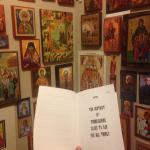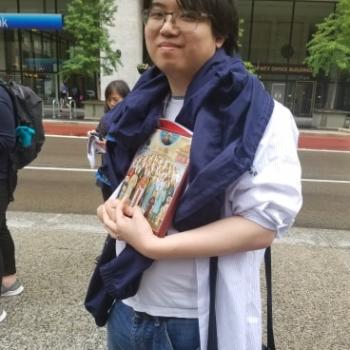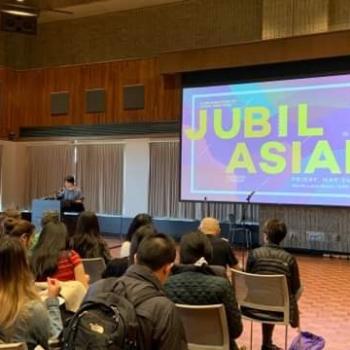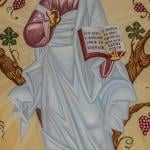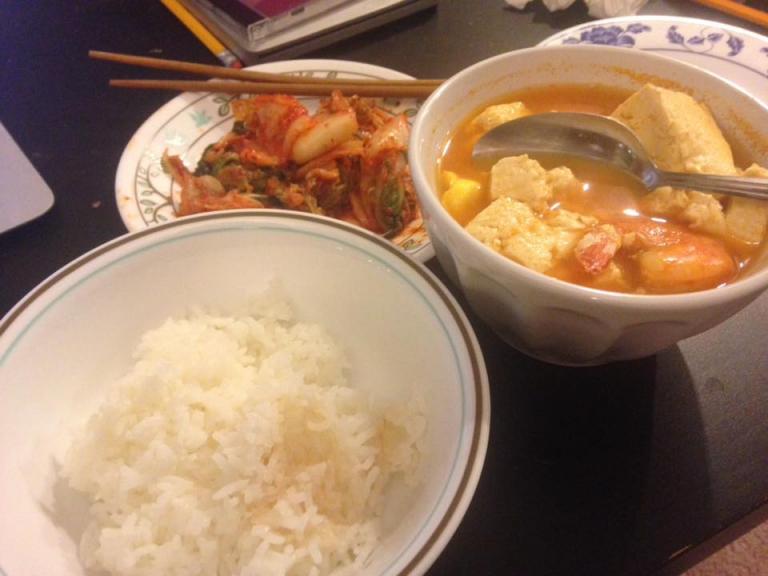
Two nights ago, I was at my dear friend and mentor Ji-Yeon Yuh’s house for American Thanksgiving. I had decided with my family in Canada that I wouldn’t come back for the weekend, as we had already celebrated the holiday in October. As it was, I was going to work right through Thanksgiving as if it were a workday, but a message from Ji-Yeon came in right on time, stopping me from my workaholism. I accepted immediately. A meal at Ji-Yeon’s is always a treat.
Ji-Yeon and I like to say to each other that we are of the same kind. That statement is pregnant with meaning in many respects, but one of them is that we are scholars in Asian American studies who are able to talk about our intellectual work through the food we make. One might be tempted to say that this is an Asian thing. Viet Thanh Nguyen, for example, often tells the story of him hearing from a deep place the intimacy of a Vietnamese father asking his child on the phone if she has ‘eaten rice’ yet. A common Asian American joke is that have you eaten yet? is Asian parent code for I love you, and while the claim that Asian parents don’t know how to hug their children or tell them I love you is overdetermined (most of us prefer to communicate physical and verbal love with an act that combines both: the kiss), it is unequivocally true that love is also to be found in the food that we make.
This sensibility, I want to point out, is not unique to we who are Cantonese, Korean, and Vietnamese. Sam Rocha, the author of Folk Phenomenology, sings a song calling on his listeners to ‘make your eggs with love‘ as a statement of how everyday life should be lived: with care and attention to the little things, acts of service through the material order to those with whom one lives. So too, the Ukrainian sisters and brothers I came to know in the Kyivan Church tell me that borshch is the foundation of a marriage. In wild contrast to the white people attempting to gaslight Alexandria Ocasio-Cortez on her beautiful black coat, there is an extravagance to the everyday lives of ordinary folks, but not one of conspicuous consumption. Only a rich man can afford cheap tools, Sam tells us in the same song about eggs with love, and after listening to it many times, I have come to agree with him — and have finally begun to take his advice, as well as many others’ (including Ji-Yeon, my body-building-Bruce-Lee-channeling New Testament scholar friend Sam Tsang, and even my own biological father) to get some new clothes that are presentable menswear. The generosity of the poor and the dynamism of the ordinary is to be found in our exquisite care for the material in everyday life, and the place where that attitude is distilled, I learned again last night, is in broth.
Broth is very important to me. My mom’s nickname for me in Cantonese is tong doi, literally ‘soup bag.’ When there is soup at a meal, I do not only consume what is in front of me — I go back for seconds, thirds, fourths, and fifths, my body with seemingly unlimited capacity for this liquid of life. I hear that this experience is universal. I have, for example, always identified deeply with the scene in Disney’s Snow White and the Seven Dwarves when Snow White makes a soup that the dwarves smell from the top of the stairs. Sniffing it, they exclaim in chorus, Soup! Hooray! and proceed to swarm the table, fighting over the goods. I am also told that the kind of soup that I like, a clear broth made of pork bones, is not completely particular to the Cantonese. My Mexican friends informed me a while ago that there is an equivalent for them. I’ve only had the one with beef bones, but it’s the same idea indeed.
What I learned from Ji-Yeon was that differences in soup theory can be beautiful too. Ji-Yeon knows me too well: I’m the kind of person who wants to participate in the making of things with my friends, and my sensibilities as a guest watching those dear to me trying to serve me are still in immature development. When she picked me up, she took me to a local Korean grocery store. I got to fill up my refrigerator with items that could only be obtained there, and over the course of talking through what materials to pick up, we discovered that there were significant differences in Cantonese and Korean soup-making. The basic theory of Cantonese soup is that there is a hunk of pork as the base, and the general idea is that you are striving for the balance of ‘hot’ and ‘cold’ forces through the herbs you put into the soup to produce something between a ‘clear’ and a ‘hearty’ broth. This is accomplished by a judicious combination of herbs, red and honey dates, dried almonds, squid, scallops, shrimps, and so on and so forth, over which can be overlaid a vegetable for stewing, such as daikon, carrots, watercress, winter melons, hairy melons, and whatever else one finds. You drink this soup by itself. It is like a hearty, hot potion.
The theory of Korean broth is different from a Cantonese one, I learned. For Korean broth, you are trying to create a soup base. The general idea is the same as all other stocks: you are boiling the essence of whatever you put in. But while it is hearty, it is not a potion; it is the basis for all other cooking. What I learned from Ji-Yeon, which broadly coincides with what the popular food blogger Maangchi also says, is that the base is basically kelp, onion, garlic, and radish, and the heartiness can come from anchovies, if that was what I wanted. Brewing that stock forms the basis for all the delicious things I’ve come to appreciate in Korean cooking – kimchi stews, red pepper paste soups, soybean paste soup. Everyone, I also discovered, should know how to make this basic stock. It is part of what it means to be an adult.
I have pondered that last bit over the last two days. I might say, Well, I don’t know how to make Korean stock because I am not Korean, with the excuse being that I am Cantonese, and what it means to be an adult is to be able to make Cantonese soup – and the same could go for borshch if I were Ukrainian. But as I filled up my refrigerator with Korean goodness, I thought of that time when my dad, a Cantonese Hung Kuen master, put me into a Taekwondo class in Fremont. I had to learn Korean then too, or at least mimic its sounds, and one time I even led the pledge to the Korean flag at the beginning of class and was complimented by the teachers, though I had no idea what I actually said. That was a time before identity, or at least around the time when it was still in formation. I may complain now, for example, that much of the time when we are discussing Asian American evangelicals, the subjects really are Korean Americans, and so I wouldn’t want to do anything that further reinforced that problem in our identity politics. But the truth is that none of my Taekwondo experience bothered me, and neither does my joyful consumption of any food with origins from Korea. With such reflections, I made anchovy stock the next day. When it was done, I put some red pepper paste, tofu, and shrimp into it. Then I tweeted it. Maangchi retweeted it. That made my day.
Despite the differences in tradition, stock is not about identity. The various traditions are perhaps better described as entry points into the universal, an ocean of broths, if you will. There is no false universality here, as I am also saying that you cannot have broth without tradition. But it is also universally true in the traditions that I have encountered over the course of my short life is that making broth is a marker of adulthood. It is a sign not only that you know how to feed yourself, but also that you are able to communicate your love to those around you through the everyday materials of life. There is something beautifully psychoanalytic about such an act. Going beyond words, the oceanic feeling itself turns out not to be one marked by trauma, as Yasmin Nair wonderfully criticizes in her newest piece on Nanette, but one baptized in love.
I suppose there is something Catholic about these reflections and that readers quick to jump to conclusions will make an interpretive leap to the Eucharist. Perhaps this is where being Eastern Catholic is helpful: we do not reduce every mystery to communion, but are happy to simply observe through the Orthodox theology of icons that grace is communicated mysteriously through the material order. But I am not saying that broth is necessarily sacramental, whether Cantonese, Korean, Mexican, or Ukrainian, although consuming it in all four traditions certainly feels like a sacred experience. Indeed, the late Episcopal priest Robert Farrar Capon dared even to call it the ‘water of life,’ encouraging readers of his theological cookbook Supper of the Lamb to invest in the regular making of stock from the leftover bones of their cooking.
When I was stuck in my scholarship, Sam Rocha once told me beautifully that it was because I was still waiting to drink from that living water. It takes a village to raise a scholar, and with the combined love of those from a variety of traditions of stock-making, I have come to see the work of writing as not unlike the brewing of this water of life from ordinary materials that can be found for cheap in grocery stores. As it is, I have decided that by way of reminding myself that scholarship is not about the application of grand theories or wild abstract speculations or the knowledge that puffs up, but really concerns the stuff of everyday life in an offering of thick description and tentative philosophical theorization that comes from the ground up, I will invest in making stock as often as I can when I try to write. I laughed at myself when I first decided that, actually, reflecting that coffee and tea are also brewed much the same way: hot water, grocery materials, and time.
These, then, are my tardy Thanksgiving reflections. I am thankful for the intellectual community that has loved me out of my academic paralysis into the scholarship of the living water of everyday life. As I ponder their love, it is truly remarkable how they showed their love to me. It was not by making me buckle down on my writing. It was by teaching me how to cook, and especially how to make soup.

